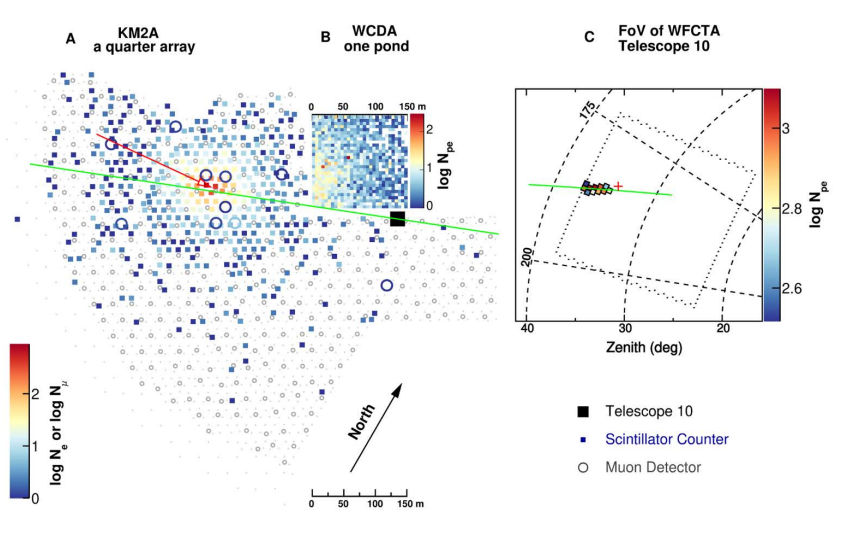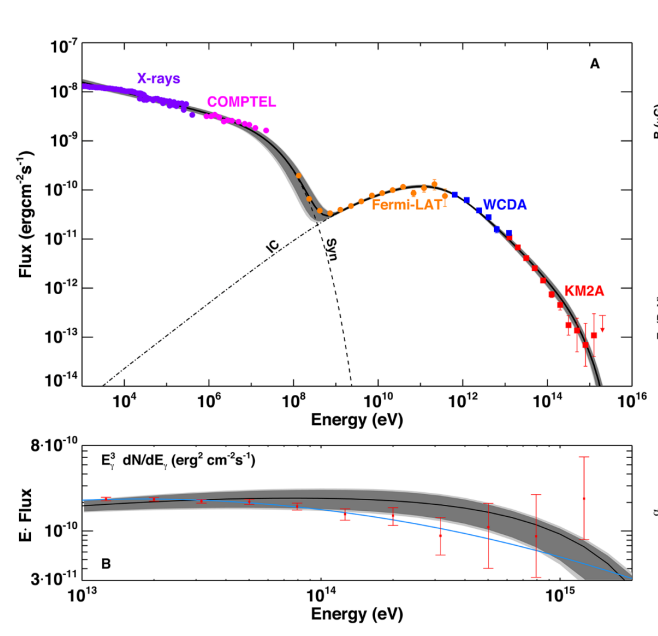Recently, the Large High Altitude Air Shower Observatory (LHAASO), the country's key national science and technology infrastructure facilities,announced that it has accurately measured the gamma spectrum of the 0.3tev ~ 1.1pev ultra-high energy band from the Crab Nebula for the first time in the world. SCU’s College of Physics has participated in the construction of LHAASO.
Being located in the constellation Taurus, the Crab Nebula was formed by the explosion of a supernova in 1054 (the beginning of the Zhihe period of the Northern Song Dynasty). Astronomers of the Northern Song Dynasty first observed the explosion and recorded it in historical books such as Song Huiyao (a collection of imperial edicts and memorials) and Song History · Astronomical Records. It was the first supernova explosion observed in human history.

A 0.88 PEV image from the Crab Nebula γ schematic diagram of photons observed by LHAASO’s three detectors at the same time

Gamma spectrum of Crab Nebula observed by LHAASO and other experiments
“The Crab Nebula is a bright source of gamma rays powered by the Crab Pulsar’s rotational energy through the formation and termination of a relativistic electron-positron wind. We report the detection of gamma rays from this source with energies from 5 × 10−4 to 1.1 peta–electron volts with a spectrum showing gradual steepening over three energy decades. --- The production rate of peta–electron volt electrons, 2.5 × 1036 ergs per second, constitutes 0.5% of the pulsar spin-down luminosity, although we cannot exclude a contribution of peta–electron volt protons to the production of the highest-energy gamma rays.” (Abstract)
This discovery, a scientific achievement of LHAASO, has been published inScienceunder the title of “PeV Gamma-ray Emission from the Crab Nebula”. The co-authors are Prof. Chaowen Yang, Associate Professor Lixin Bai, Associate Professor Rong Zhou, Associate Professor Zhonghai Wang and graduate students Sen Hu, Jian Chen, Yao Li, Zhangxing Liu and Jinwen Zhang.
Being located in the mountains (altitude of 4,410 meters) of Daocheng county, Sichuan province, LHAASO consists of three detector arrays: KM2A, WCDA and WFCTA. Different types of detectors have cross inspection ability. It is the largest and most sensitive cosmic ray observatory in the world. The College of Physics has undertaken the design, development, production, calibration, commissioning, operation and data processing of signal readout electronics of WCDA and WFCTA detectors. It plays a crucial role in the LHAASO project and is an important member of LHAASO cooperation group.
https://science.sciencemag.org/content/early/2021/07/07/science.abg5137/tab-pdf
